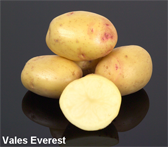Utilisation of the Commonwealth Potato Collection in potato breeding
Bradshaw and Ramsay (2005) have recently reviewed the utilisation of the Commonwealth Potato Collection (CPC) in potato breeding at the Institute and its predecessor the Scottish Plant Breeding Station. Here we want to emphasise the use of the CPC in breeding recently released cultivars.
 Lady Balfour (2001) is now the number one organic variety in Britain. It has partial resistance to both the golden and the white potato cyst nematodes derived from the diploid South American species Solanum vernei (CPC2487 and 2488). The CPC accessions were treated with colchicine in 1957 to produce tetraploid S. vernei for crossing with cultivars of the European potato. Lady Balfour is six generations removed from S. vernei.
Lady Balfour (2001) is now the number one organic variety in Britain. It has partial resistance to both the golden and the white potato cyst nematodes derived from the diploid South American species Solanum vernei (CPC2487 and 2488). The CPC accessions were treated with colchicine in 1957 to produce tetraploid S. vernei for crossing with cultivars of the European potato. Lady Balfour is six generations removed from S. vernei.
 Vales Sovereign (2003) is the latest in a line of cultivars dating back to Pentland Javelin (1968) with the H1 gene from Andigena potato CPC1673. This continues to provide resistance to the only pathotype of the golden potato cyst nematode present in Britain. Vales Sovereign came from a research programme to increase the copy number of the H1 gene in parents so that all, or nearly all, of their progeny are resistant even when the other parent is susceptible. This avoids the need to screen the progeny for resistance or waste resources on raising susceptible seedlings. However, it involves time-consuming progeny testing, so a molecular marker diagnostic of H1and a way to assess copy number are being sought.
Vales Sovereign (2003) is the latest in a line of cultivars dating back to Pentland Javelin (1968) with the H1 gene from Andigena potato CPC1673. This continues to provide resistance to the only pathotype of the golden potato cyst nematode present in Britain. Vales Sovereign came from a research programme to increase the copy number of the H1 gene in parents so that all, or nearly all, of their progeny are resistant even when the other parent is susceptible. This avoids the need to screen the progeny for resistance or waste resources on raising susceptible seedlings. However, it involves time-consuming progeny testing, so a molecular marker diagnostic of H1and a way to assess copy number are being sought.
 Vales Everest (2005) has the best resistance to the white potato cyst nematode of varieties currently on the National List. This resistance is derived from Andigena potato CPC2802 which was found to be resistant in 1969. Vales Everest is five generations removed from CPC2802.
Vales Everest (2005) has the best resistance to the white potato cyst nematode of varieties currently on the National List. This resistance is derived from Andigena potato CPC2802 which was found to be resistant in 1969. Vales Everest is five generations removed from CPC2802.
The six diploid Phureja cultivars (see image at top of page), Mayan Gold (2001), Inca Sun (2001), Inca Dawn (2003), Mayan Queen (2008), Mayan Star (2008) and Mayan Twilight (2008), are all derived from the long-day-adapted population produced from CPC accessions over the period 1962-1979. Although the original purpose was to widen the genetic base of tetraploid potatoes, these cultivars are finding valuable niche markets for their flavour attributes. Phureja potatoes are the second most widely cultivated type in the Andes of South America and our cultivars are the first to be commercialised in Europe.





